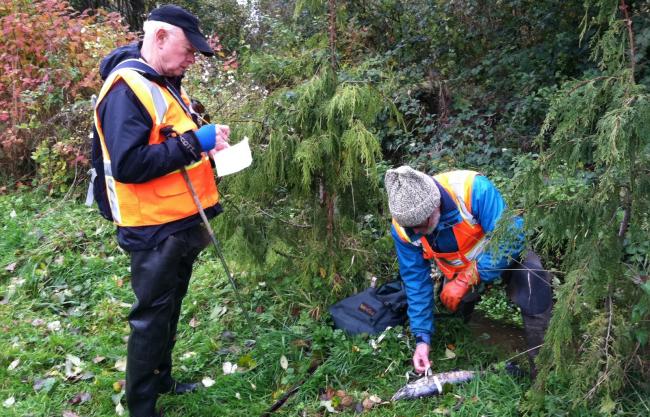CSI: Highline investigation uncovers more salmon in streams
Bill Baldwin, left, takes notes as Lee Moyer measures the fish.
Mon, 01/09/2012
By Gwen Davis
The results are in: The salmon runs of Miller and Walker creeks in Burien and Normandy Park were larger this year than last year, but more work still needs to be done to keep the stream water clean.
The findings are in thanks to the volunteer-based Community Salmon Investigation for Highline program, also known as CSI: Highline, which evaluates the health status of the creeks by counting the dead and alive coho and chum salmon on the shores-- paying particular attention to the dead pre-spawned salmon.
The fish count and pre-spawned mortality rate serve as a long-term indicator of whether the water and surrounding land is clean and healthy.
Twenty-one volunteers surveyed the streams this season. Volunteers were assigned into teams of two to three people, with each team surveying one day of the week.
The season ran from Oct. 10 to Dec. 23.
Volunteers collected the dead and alive fish, and if dead, cut them open to determine if they had spawned.
Fish that died before spawning were a solid indicator of dirty water.
Elissa Ostergaard of the Miller-Walker Creek Basin Stewardship Program and coordinator of CSI: Highline said that this year’s number of live fish was “amazing” compared to last year’s number.
Volunteers counted 419 live coho salmon and 508 live chum salmon, compared to last year’s 25 live coho and 342 live chum.
“It was amazing,” Ostergaard said. “We don’t know why there were so many more this year than last year.”
The 39 percent pre-spawn mortality rate was also lower than last year’s, however, 87 dead coho were found this year, compared to last year’s 6.
Sixty-three percent of the dead coho were from hatcheries. Hatchery fish are easily identified by the loss of their adipose fin, which hatcheries slice specifically for such identification purposes.
Ostergaard said the percentage of fish that were of wild origin, was a good sign. But, she noted, it is impossible to tell if the wild fish presence was because of better conditions in the streams or better conditions in the ocean, or a number of many other factors.
“There might have been good enough conditions in the streams for wild fish to come to the ocean over the winter and come back,” Ostergaard said. “But it could be due to the conditions in the ocean, including how much food was there, what the climate was doing, which predators where there, and so on.”
The work to keep streams healthy is far from over.
“The almost 40 percent pre-spawned mortality rate means we have to work harder on cleaning up the water,” Ostergaard said. “We also have to make sure any wash water doesn’t get into the storm drain, since it’s not treated before it goes into the drain.”
Ostergaard and the Miller-Walker Creek Basin Stewardship Program continue to stress the importance of not washing cars in driveways since the soap gets into the streams and harms the aquatic creatures.
The program is looking for more ways to filter stream water and to control invasive plant species growing along the stream. Planting trees around the basin would help to capture more pollution, Ostergaard added.
Yet overall, the results this year were significant.
“Much better than last year’s,” Ostergaard said. “Not perfect, but it could mean healthier water.”


